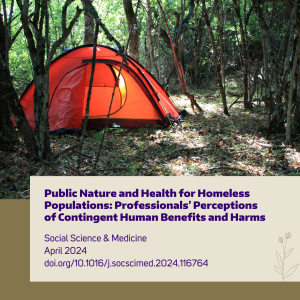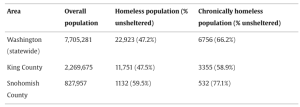Public Nature and Health for Homeless Populations: Professionals’ Perceptions of Contingent Human Benefits and Harms
Citation
Derrien, M. M., Bratman, G. N., Cerveny, L. K., Levy, C., Blahna, D. J., Frank, P., & Serio, N. (2024). Public nature and health for homeless populations: Professionals’ perceptions of contingent human benefits and harms. Social Science & Medicine, 347(14), 116764. https://doi.org/10.1016/j.socscimed.2024.116764
 This study explores how living in public natural areas—such as parks and forests—affects the health of people experiencing unsheltered homelessness in the Seattle region. To understand this, researchers interviewed professionals who work closely with this population, including environmental workers, social service providers, and law enforcement officers. The interviews were analyzed to identify common themes about physical and mental health impacts.
This study explores how living in public natural areas—such as parks and forests—affects the health of people experiencing unsheltered homelessness in the Seattle region. To understand this, researchers interviewed professionals who work closely with this population, including environmental workers, social service providers, and law enforcement officers. The interviews were analyzed to identify common themes about physical and mental health impacts.
According to these professionals, natural environments can offer important benefits, such as peace, quiet, and relief from urban stress. At the same time, they can also pose serious risks, including exposure to harsh weather, unsafe conditions, and limited access to basic resources. The professionals noted that the health effects vary widely depending on each person’s situation and on changing environmental and social conditions.
The findings suggest that while nature can provide much-needed support, people experiencing homelessness may be especially vulnerable when conditions shift. The study concludes with insights for future research that directly measures how living in public natural areas influences the health of unsheltered homeless individuals.
Abstract

- Professionals observe benefits and harms of natural area use for homeless populations.
- Perceived harms include increased environmental exposures and social vulnerability.
- Perceived benefits include privacy, desired social conditions, and reduced stress.
- Relationships between nature and health were seen as variable and context dependent.
This article investigates relationships between public nature and health for unsheltered homeless populations. It examines perceptions of health benefits and harms for people living in public natural areas including local, state, and national forests and parks in the Seattle metropolitan area (USA). Interviews with environmental, social service, and law enforcement professionals who regularly interact with this vulnerable population were conducted and thematically analyzed to understand perceptions of physical and mental health outcomes. Results show professionals’ perspectives on the health benefits and detriments of time spent in natural environments and the contextual factors perceived to influence health. Interviewees’ observations about the variability of personal circumstances and biophysical, social, and weather conditions encourage the nuanced consideration of how contingent therapeutic landscapes provide deeply needed benefits, but for a population with a diminished capacity to adapt when conditions change. We conclude with insights for future research that directly assesses homeless populations’ exposures and health outcomes of living in public natural areas.